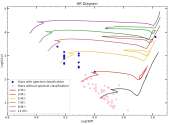Astronomers inspect open cluster Berkeley 50
Using the Lowell Discovery Telescope (LDT), astronomers from the Lowell Observatory in Flagstaff, Arizona, have observed a young Galactic open cluster known as Berkeley 50. Results of the observational campaign, presented ...









